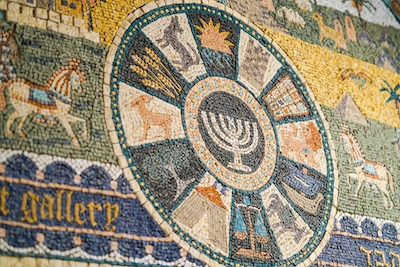Growing up in England, I found it funny that in America, synagogues are sometimes called temples. To us, temples were something our Hindu neighbors had — anathema by traditional Jewish standards, with their stone carvings of elephants and buxom milkmaids, and correspondingly fascinating. In a Jewish context, the word Temple could only mean one thing: the ancient shrine in Jerusalem, twice destroyed by conquerors — Babylonians in 587 BCE and Romans 650 years later. It is these desecrations mourned on last Tuesday’s fast of Tisha B’Av, the most tragic day of the Jewish calendar.
In the prayer books I grew up with, a wish to rebuild the Temple forms a coda to all the central liturgies. Alongside anticipation of the messiah, it is a core Jewish philosophy that some adhere to literally, some wish to reinterpret, and many would prefer to overlook. But for those of us called to consider what sort of third Temple we might actually want to see established, it is important to interrogate our understanding of the previous ones.
The first thing to note is that these previous Temples are mostly literary constructions. The perfected imaginal space projected by the Talmud has far outlasted the messy reality of the shrine that once stood in Jerusalem, eclipsing the corruption, rivalry and appropriation of secular power that marked much of its existence.

Help us keep Jewish knowledge accessible to millions of people around the world.
Your donation to My Jewish Learning fuels endless journeys of Jewish discovery. With your help, My Jewish Learning can continue to provide nonstop opportunities for learning, connection and growth.
In fact, Jewish tradition is by no means clear that having a Temple is unequivocally desirable. This week’s Torah portion, Vaetchanan, insists repeatedly that law be the center of religious life, never images or objects. Even though Solomon’s construction of the first Temple is apparently blessed by God, the biblical authors still strike a note of ambivalence, questioning whether God really needs a fixed abode (2 Samuel 7:6-7) or how a mere building could possibly house that which the cosmos itself cannot contain (1 Kings 8:27).
This ambivalence extends even to the Mishkan, the peripatetic prototype of the Temple that the Israelites travel with in the wilderness. Juxtaposed with the people’s disastrous creation of a golden calf, the Mishkan is seen as a compromise, God’s reluctant accommodation of a human need to have a physical focus for worship. Indeed, God’s original instruction — “Create for Me a holy space, and I will dwell within them” (Exodus 25:8) — is widely understood to mean that the people themselves should be that holy space that God can inhabit.
Expanding on this idea, the sages dwell on the parallels between the physical structure and furniture of the Temple and the form of the human body. An ancient midrash (Genesis Rabbah 8:1) observes that the same Hebrew word, tzela, is used to describe both Adam’s side, from which Eve is fashioned, and the side of the Mishkan, while later commentators understand the Temple as an externalized map of our sacred human faculties: the menorah for our power of sight, incense for smell, sacrificial altar for taste, and so forth.
At the epicenter of both Temple and Mishkan was the ark of the covenant, which the Talmud tells us contained not only the second set of stone tablets brought down by Moses from Mount Sinai, but also the sacred fragments of the first, implying that the brokenness within us is as holy as that which is whole. The ark is described by the midrash (Tanchuma 7) as God’s bed, and upon its cover were the forms of two golden cherubim embracing each other, representing to us the sacredness of love and eros. Both of these concerns are as human as they are divine.
The idea that each person is a mikdash me’at, or miniature sanctuary, is one way Jewish thought decentralizes the physical Temple. Another is the Talmud’s beautiful teaching (Berakhot 55a) that, in lieu of a central shrine, every household becomes a locus for divine communion: our own tables, complete with ritual items like kiddush cup, Shabbat candles and havdalah spices, are microcosms of the Temple’s altar, libations, menorah and incense.
These moves to domesticate the Temple push against the notion of a singular, indispensable shrine and toward the idea of human life itself being God’s home. The Talmud also tells us that each of Jerusalem’s Temples was in turn destroyed by the dysfunction of the society it represented — the first because the people were too unbounded, compelled by violence, idolatry and lust; the second because of sinat chinam, baseless hatred that fractured the community. Presumably we must heal these dysfunctions before creating any future focal Jewish space.
In the kabbalistic imagination, these two dysfunctions, unboundedness and hatred, represent the shadow sides of two sefirot, or divine emanations: chessed, love and desire, and gevurah, boundedness and containment. Correspondingly, as we ask ourselves what a third Temple might look like, we are called to evolve beyond transcend not only rapacity and prejudice, but also the shadow of the next sefirah: tiferet, or radiant harmony. Tiferet, radiant harmony, integrates chessed and gevurah, but its shadow is self-aggrandizement and particularism.
This is an important consideration as we contend with the idea of a literal third Temple in a specific place, a place that happens to be the holy site of a sister religion. Rather, we might learn from our historic wrestling against attempts to tie God to a single location, and the bad mixture of religion and power this tends to promote. Let us instead look to the prophetic teachings of Rabbi Chaim Hirschensohn, who envisioned that the third Temple would be a “court of the nations,” protecting and promoting universal human rights.
For if every single one of us is a miniature sanctuary, and every home is a place for God to dwell, then truly the third Temple must be everywhere, and its construction begins with us.
This article initially appeared in My Jewish Learning’s Shabbat newsletter Recharge on August 17, 2024. To sign up to receive Recharge each week in your inbox, click here.



